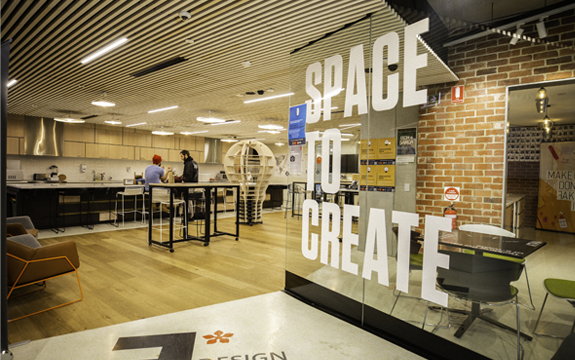Innovation fellowships boost staff startup ambitions

In Summary
- Three staff have been named as Innovation Fellows by the Innovation Precinct
- Fellows represent the three faculties: Health, Arts and Design; Science, Engineering and Technology; and Business and Law
- These fellows will be engaging with the innovation ecosystem as they develop their startup idea
This year, Swinburne’s Innovation Precinct has named an architectural engineer, a flexible working expert and a biodevices engineer as Innovation Fellows.
The Innovation Fellows program supports Swinburne researchers to develop a startup idea. Fellows receive one day a week to develop their idea into a marketable product or service, as well as access to mentoring and masterclasses
This year’s participants are the School of Design’s Dr Gregory Quinn, Swinburne Business School’s Dr John Hopkins and Director of the ARC Training Centre in Biodevices, Professor Paul Stoddart.
Classroom in a box
For his Innovation Fellowship, Dr Quinn is seeking to develop a startup around a novel learning tool, ‘constructAR’ (working title), for science and engineering.
“I see architectural engineering as a deeply creative pursuit, and my research bridges these fields to create innovative technologies and solutions that strive to make a positive impact on the world,” he says.
constructAR – augmented reality construction - gives its user unprecedented ability to design, build and physically interact with structural and mechanical components.
“Existing teaching aids tend to be clunky with no customisability. Through constructAR, users can interact in real-time with physical components that closely resemble the schematic symbols used in teaching. For example, users can explore various ways to stabilise a frame, or understand the buckling of a column” Dr Quinn explains.
“This fellowship will help push my innovation forward in gaining traction and funding. I hope to evolve this project into a business based on a teaching tool that will transform STEM education” he adds.
Dr Quinn credits Swinburne’s 3D printing and workshop equipment for making his project feasible in a short amount of time.
Workplace flexibility
Dr Hopkins has always been a proponent of flexible work.
“Over the past five years, I have been involved in several research projects that focus on workplace flexibility and examining how modern technologies affect how, when and where we perform our daily work activities,” he says.
He will now delve deeper into this area for his Innovation Fellowship.
“The startup idea I will be developing is an online flexibility health check that can measure the current level of workplace flexibility present in a business unit, identify areas of weaknesses and develop an improvement plan to address these weaknesses. The support and workload allocation I will receive from this program will give me the invaluable opportunity to engage with the Innovation Precinct and launch my idea”

Participants of Dr Hopkins’ research credited better health, family and work outcomes to a flexible work environment.
Optical fibres as a sensing technology
Professor Stoddart’s team at the ARC Training Centre in Biodevices has been developing a sensing technology based on the scattering of laser light from nanometre-scale gold and silver particles.
“This scattering is extremely sensitive to chemicals on the metal surface and the resulting spectrum can be used to sense these chemicals. This phenomenon has potential applications in cancer diagnostics, environmental monitoring and the detection of food contaminants” he explains.
The team’s latest research has demonstrated the feasibility of a micro-miniaturised optical fibre probe with improved sensitivity and a robust surface chemistry for sensing target molecules at ultra-low concentrations.
“The fellowship program will provide a structured way of investigating different ‘go to market’ strategies. Ultimately, we would like to seed a home-grown biosensing company with products that address important societal problems and generate exciting employment opportunities” Professor Stoddart adds.

